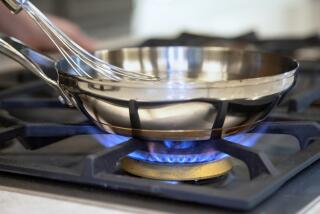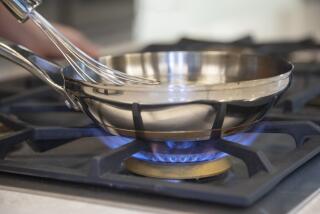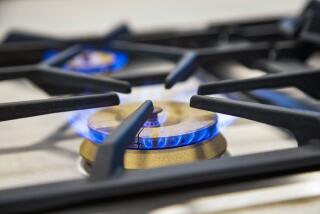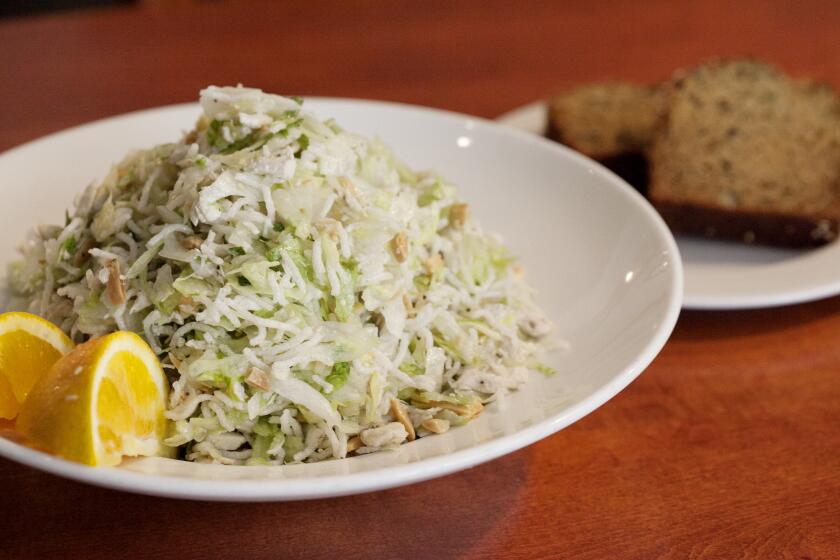Chef Serves Up Food for Thought to Buyers of Appliances
- Share via
Behind every successful chef stand his appliances.
If they aren’t chosen well, maintained well and cleaned frequently, he or she can’t do the job, said G. Michael Harris, an executive chef for 20 years and a professor in the food and hospitality program at Bethune Cookman College in Daytona Beach, Fla.
Can a chef’s insights be useful to the buyer of a newly built home? Absolutely. In a recent interview, Harris offered some advice on selecting appliances.
Though most home buyers would probably begin any discussion on appliances with the big-ticket items, Harris starts with the food preparation sequence and small appliances that blend, mix and chop.
The first question he asks: “Do I really need it?”
With a bigger kitchen, many new-home buyers have a tendency to go overboard, but Harris said, “even if you cook a lot, a mixer and food processor will cover most things.”
After whittling down the number of small-motor appliances to the essentials, Harris said the next question is where to put them.
In most kitchens, “they’re always in the way, taking up counter space, but the attachments are stuck in some drawer and you can’t find them when you want them.”
Harris’ solution: a “speed rack” with two or three shelves on wheels; each shelf holds one appliance and all its attachments. This works well if the kitchen has a large pantry for storing the speed rack when it’s not in use, as Harris’ has.
If there’s no room for a speed rack, Harris suggests inserting an extra wall cabinet with folding doors in the space between the counter and the underside of a standard wall cabinet.
Trendy appliance garages with their wooden accordion sliding doors that are often set into this space “look ugly and the sliding doors break,” Harris said.
When it comes to picking a range and oven, Harris begins with the prosaic question, “How easy it is to clean?”
More than once, he said, he’s found himself muttering, “The person who designed this never had to clean it.” When choosing between a gas or an electric range, Harris said he would always choose gas because the cooking temperature can be set more precisely. And, he added, he would spring for a more expensive gas range with sealed burners that are much easier to clean, a feature most gas range manufacturers now offer.
In ovens, gas and electricity work equally well, but for ease of cleaning, Harris would get an electric oven with a self-cleaning feature. If the oven has to be gas, Harris would put a cookie sheet on the bottom of the oven to catch spills.
Another important cooking “appliance,” though it’s rarely thought of as such, is the exhaust fan, Harris said.
The fan needs to be big enough to do its job--exhaust smells, steam, smoke and noxious by-products such as carbon monoxide from incomplete combustion of the gas burners.
This air-cleansing mechanism also has to exhaust these to the outside, not just move air through a charcoal filter, as do some built-in exhausts that come on a stove unit.
The exhaust system must also be periodically cleaned and the grease that collects in it removed, Harris noted. Otherwise, the grease builds up, creating a fire hazard.
In a house, a cleaning once a year is adequate, he said.
For houses which people entertain infrequently, Harris said, a residential-size range rather than a large, expensive “trophy stove,” is the sensible choice.
For those occasions when cooking large quantities of food is necessary, he would get a large outdoor barbecue grill. For ease of cleaning, the grill should be gas-fired. If a gas line to the backyard cannot be installed when the house is built, Harris would use a refillable propane gas tank.
As for dishwashers, Harris recommends one with a stainless steel interior. This feature will add to the cost, but it will also increase the life of the dishwasher because it won’t chip or corrode as a conventional dishwasher lining eventually will.
As for refrigerators, Harris observed that most people find a side-by-side type easier to organize and use than a freezer unit above or below the refrigerator, even though the storage capacity may be the same.
A unit with glass shelves--usually an upgrade feature--will keep spills localized and prevent that leaky bottle of sticky syrup on the top shelf from dripping over everything below it.
Though the frost-free feature has made many homeowners oblivious to any regular refrigerator maintenance, Harris urged homeowners to clean it out periodically “top to bottom” to prevent the interior from getting corroded or pitted.
If door gaskets are not kept clean and periodically replaced, the interior temperatures will not be in the correct range--36 to 40 degrees Fahrenheit for the refrigerator and zero degrees for the freezer--and the food will spoil faster, he said.
About added features on appliances, Harris was cautious.
“The added bells and whistles are usually functions I don’t need and just one more thing to break. In many cases now, if one function is on the fritz, the whole machine breaks down. For example, if the more sophisticated timer on the oven breaks, the entire oven won’t work.”
Katherine Salant is a syndicated columnist who writes on newly built homes. She can be reached via e-mail at [email protected].
More to Read
Eat your way across L.A.
Get our weekly Tasting Notes newsletter for reviews, news and more.
You may occasionally receive promotional content from the Los Angeles Times.










